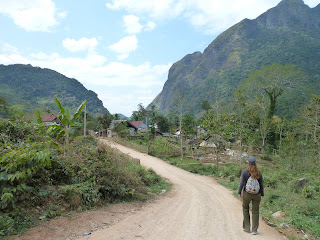We ventured away from the relative luxury of Luang Prabang, traveling north to to a small mountain town called Nong Khiaw. Straddling the Nam Ou River, a tributary to the mighty Mekong, it is surrounded by impressive limestone karst mountains. We explored nearby villages by boat and on foot. Danielle bought an inexpensive hand-made scarf from a girl who spent three days at her loom making it.
The people of Laos are a complex array of hill tribes with varying customs and language, but they all depend to some degree on the rivers of their land-locked country. The Nam Ou, sadly, is due to be dammed in several places as part of a massive Chinese-financed hydroelectric project. Laos is emerging from political isolation, and China is quite willing to sponsor infrastructure projects in exchange for a large share of its neighbors' natural resources. We saw some 30 villagers dragging a concrete power pole up a muddy bank, a few feet at a time. We also saw the first street lamps being installed in Nong Khiaw, soon to mute the starry skies. It was interesting to be in Laos during this period of transition, when an average wage yields $1500 per year, but SUVs are beginning to clog the quiet city streets. While we loved Laos cuisine -- especially their extra-sticky sticky rice -- the markets still illustrate the nation's overall poverty and reliance on wild foods... river fish, rodents, crickets and grubs, songbirds and pounded river weed are all on the menu.
We then made our way the central plains of Laos, to a ecolodge on the Nam Ngum river. We hiked through the rainforest, and canoed and swam in the deceptively strong current. To illustrate how close to nature we were, I'll share that we were very slow and sparing with the toilet paper so as not to disturb the resident orange frog.
Finally, we spent several days in the small capitol city, Vientiane. Travelers generally don't hold this city in high regard. Unlike Luang Prabang, which is entirely given over to catering to tourists, there is not much to 'do or see' here. So, we loved it. We enjoyed loitering around the Mekong River waterfront at sunset, watching the kids proudly pedal their fixed-gear bikes, the joggers, and the outdoor aerobics classes punching the air. We enjoyed watching workers playing the Lao version of bocce on their coffee breaks. Overall, we were very charmed by all the friendly people we encountered in Laos and consider ourselves very fortunate to visit.
One last note, Laos was relentlessly bombed by America during the Vietnam War, in an unsuccessful attempt to cut off the Ho Chi Minh trail. It was a secret and illegal bombardment of a neutral country, with an average of one B-52 payload dropped on Laos every 8 minutes over several years. There were no rules of engagement, so anything or anyone that moved was a viable target. Hundreds of innocents still die every year, as approximately 30% of the bombs didn't explode. The unexploded ordinance (UXO) is hidden in the soil and will blow up with the slightest unintentional disturbance -- be it a farmer clearing land or children building a campfire. On the other hand, victims are often children that hunt for scrap metal to sell on the black market -- knowing full well the risks but desperate for cash. Hospitals are ill equipped to help the injured, and those maimed individuals that survive often waste away in remote villages, unknown to authorities. We visited and contributed what we could to the Cope Center, a rehabilitation center with several important programs. For everyone who is moved, and especially us American taxpayers who finance these wars (even inadvertently), please consider a small donation to their sorely needed programs. I think of it as token recompense for a lethal legacy, but a humble and heartfelt gesture all the same. ~Micah
www.copecenter.org










I love the frog in the toilet paper roll! You guys are going everywhere! super cool, love seeing your adventures!
ReplyDelete